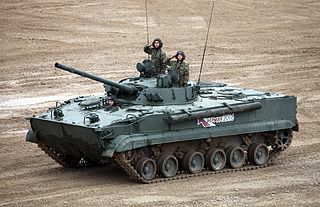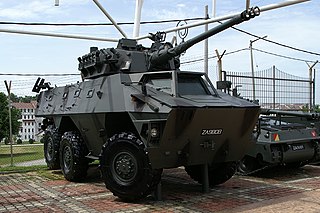
The BMP-3 is a Soviet and Russian infantry fighting vehicle, successor to the BMP-1 and BMP-2. The abbreviation BMP stands for Boevaya Mashina Pekhoty.

The Combat Vehicle 90 (CV90) is a family of Swedish tracked armoured combat vehicles designed by the Swedish Defence Materiel Administration (FMV), Hägglund & Söner and Bofors during the mid-1980s to early 1990s, before entering service in Sweden in the mid-1990s. The CV90 platform design has continuously evolved from the Mk 0 to the current Mk IV with technological advances and changing battlefield requirements.

The Boxer is a multirole armoured fighting vehicle designed by an international consortium to accomplish a number of operations through the use of installable mission modules. The governments participating in the Boxer programme have changed as the programme has developed. The Boxer vehicle is produced by the ARTEC GmbH industrial group, and the programme is being managed by OCCAR. ARTEC GmbH is based in Munich; its parent companies are Krauss-Maffei Wegmann GmbH and Rheinmetall Military Vehicles GmbH on the German side, and Rheinmetall Defence Nederland B.V. for the Netherlands. Overall, Rheinmetall has a 64% stake in the joint venture.

The Schützenpanzer Marder 1 is a tracked German infantry fighting vehicle designed for use with the West German Panzergrenadiere units, mechanized infantry specialized for IFV combat. It has been operated by the German Army as the main Panzergrenadiere IFV since the 1970s through to the present day. Developed as part of the rebuilding of West Germany's armoured fighting vehicle industry, the Marder has proven to be a successful and solid infantry fighting vehicle design.

The Warrior tracked vehicle family is a series of British armoured vehicles, originally developed to replace FV430 series armoured vehicles. The Warrior started life as the MCV-80, "Mechanised Combat Vehicle for the 1980s". One of the requirements of the new vehicle was a top speed able to keep up with the projected new MBT, the MBT-80 – later cancelled and replaced by what became the Challenger 1 – which the FV432 armoured personnel carrier could not. The project was begun in 1972; GKN Defence won the production contract in 1984 and the Warrior was accepted for service with the British Army in November 1984. Production commenced in January 1986 at Telford, with the first vehicles completed in December that year. GKN Defence was purchased by BAE Systems, via Alvis plc.

The Dardo is an infantry fighting vehicle designed for the Italian Army as a replacement for the M113 APC. It is designed and built by the Iveco Fiat Oto Melara Syndicated Company based in Rome. Iveco is responsible for the hull and propulsion systems, while Oto Melara is responsible for the weapons and fire control systems.

The Bionix (BX) is a family of tracked Singaporean armoured fighting vehicles developed by ST Kinetics. Intended to augment the Singapore Army's aging M113 armoured personnel carriers, it is the first indigenous armoured vehicle to be developed in Southeast Asia. The Bionix has been operational with the Singapore Armed Forces (SAF) since 1999 in a wide variety of adaptations including the Bionix II, Bionix 25 and Bionix 40/50 variants.

The ASCOD armoured fighting vehicle family is the product of a cooperation agreement between Austrian Steyr-Daimler-Puch AG and Spanish General Dynamics Santa Bárbara Sistemas. Both companies are now divisions of a unit of General Dynamics. The ASCOD family includes the LT 105 light tank equipped with a 105 mm gun, a surface-to-air missile launcher, an anti-tank guided missile launcher, mortar carrier, R&R vehicle, command-and-control vehicle, ambulance, artillery observer, and the AIFV model.

The Puma is a German infantry fighting vehicle (IFV) designed to replace the aging Marder IFVs currently in service with the German Army. Production of the first batch of 350 vehicles began in 2010 and was completed in August 2021. A second batch of 229 Pumas received funding. Mass production began on 6 July 2009. The companies responsible for this project are Krauss-Maffei Wegmann and Rheinmetall Landsysteme, which created a joint venture, Projekt System Management GmbH (PSM). The Puma is one of the world's best-protected IFVs, while still having a high power-to-weight ratio.

The K200 KIFV is a South Korean armored personnel carrier, originally produced by Daewoo Heavy Industries as a domestic replacement for older armored personnel carriers, such as the M113, in front line service with the Republic of Korea Armed Forces at the time of the K200's development. Since 2009 the K200 has been supplemented by the K21. A total of 2,383 K200 vehicles of all configurations were produced between 1985 and 2006, among which are 111 K200A1 vehicles exported to Malaysia.

The WZ-551 is a Chinese wheeled infantry fighting vehicle family. The name WZ-551 actually covers two families of vehicles with the official designations in the People's Liberation Army (PLA) – Type 90 and Type 92. Over 3,000 WZ-551s are in service with the PLA, where they are used by medium mechanized infantry units.

The ZBD-04 or Type 04 is a Chinese infantry fighting vehicle. It bears some external resemblance to the BMP-3, particularly with regards to its turret and main armament; However, the chassis and internal subsystem possesses a different layout. The earliest prototypes received the designation ZBD-97. An improved version, ZBD-04A, is the vehicle currently in service and being produced.

Abhay was an Infantry Combat Vehicle (ICV) developed under a technology-demonstrator program created in India by the Defence Research and Development Organisation (DRDO). Abhay would serve as the technology demonstrator for the replacement vehicle of the BMP-II ICVs India used at the time, now called the Future Infantry Combat Vehicle Program, and allowed DRDO to experience the indigenous (local) development of nearly the entire ICV and its systems.
FNSS Savunma Sistemleri A.Ş. is a Turkish defense manufacturer founded in 1988. It is owned 51% by Nurol Holding of Turkey and 49% by British–American firm BAE Systems Inc., and operates facilities located in Gölbaşı, Ankara.

Tulpar is a Turkish heavy infantry fighting vehicle designed by the Sakarya-based automotive manufacturer Otokar. It is named after the Tulpar, a winged horse in Turkic mythology.

The SIBMAS is a Belgian amphibious infantry fighting vehicle. It was engineered from the same prototype as the South African Ratel. In appearance the vehicle is also similar to the Chinese WZ-523 armoured personnel carrier. The SIBMAS was developed between 1975 and 1976 at a department of the BN Constructions Ferroviaires et Metalliques in Nivelles. Production was on an order-by-order basis and commenced only for the Malaysian Army.

The K808/806 White Tiger wheeled armored personnel carrier (APC) is family of 8x8 and 6x6 armored vehicles. Developed by Hyundai Rotem as a private venture in 2012, the Korean Army declared a plan to acquire 600 6×6 and 8×8 wheeled APCs in order to help build rapid response forces molded after U.S. Stryker combat brigades, according to the Defense Acquisition Program Administration (DAPA). Hyundai Rotem, a, made the K808/806 in competition with the Doosan Black Fox and Samsung Techwin MPV, and eventually won the competition.

The Lynx is a German armoured fighting vehicle developed by Rheinmetall Landsysteme. The Lynx, configured as a KF31 infantry fighting vehicle (IFV), was unveiled at the Eurosatory defence exhibition on 14 June 2016. The KF41 variant was unveiled at the Eurosatory defence exhibition on 12 June 2018. According to Rheinmetall, the Lynx family of tracked armoured vehicles is at the forefront of a new trend in IFV design toward armoured vehicles with lower unit and through-life costs and reduced complexity. One of the key principles of the Lynx concept is the integration of proven sub-systems with a high technology readiness level to reduce development time, cost and technical risk.

Kaplan MT or Harimau is a light tank jointly developed by Turkish manufacturer FNSS and Indonesian manufacturer Pindad. The development program name for the tank is Modern Medium Weight Tank (MMWT). The tank itself is called Kaplan MT by Turkey and Harimau by Indonesia, both meaning "tiger".

The Hunter Armoured Fighting Vehicle is a tracked Singaporean armoured fighting vehicle jointly developed by ST Engineering, Defence Science and Technology Agency, and the Singapore Army. Intended to replace the Singapore Army's aging Ultra M113 armoured personnel carriers, it was commissioned in 2019. It is the Singapore Army's and the world's first fully digitalised platform, and is designed to provide armoured forces with enhanced capabilities to operate more effectively and efficiently in various phases of military operations. It was formerly known as ST Kinetics Next Generation Armoured Fighting Vehicle (NGAFV).





















